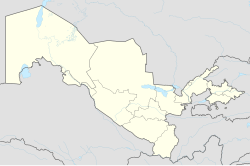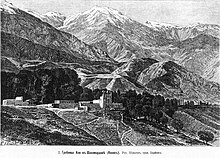Shohimardon
|
Shohimardon Шоҳимардон |
||
|
Boundaries around Shohimardon |
||
| Basic data | ||
|---|---|---|
| State : |
|
|
| Province: | Fargʻona | |
| Coordinates : | 39 ° 59 ′ N , 71 ° 48 ′ E | |
|
Location of the Shohimardon exclave on a map of Uzbekistan |
||
| Height : | 1500 m | |
| Area : | 90 km² | |
| Residents : | 5,100 (1993) | |
Shohimardon (also Shakhimardan ; Russian Шахимардан Schachimardan ; Persian شاه مردان, DMG šāh-e mardān , 'King of the People') is a place in the Fergana Valley . Shohimardon is an Uzbek exclave and completely enclosed by Kyrgyz national territory. Today's enclave has an area of 90 km² and a population of 5,100 people (as of 1993), of which over 90% are Uzbeks and around 9% are Kyrgyz .
location
Shohimardon is located 55 km south of Fergana , from where an asphalt road leads through the Kyrgyz Batken area ( Kadamschai district ) to Shohimardon. Shohimardon, surrounded by mountains, is at 1500 meters above sea level and is known as the "Switzerland of Uzbekistan". The landscape is shaped by the Alai Mountains and awaits with meadows, green forests, medicinal springs and lakes, including Lake Ko'k-Ko'l (also Kullikurban , Kurbankul , "blue lake") , which was created in 1776 as a result of severe tremors . The mountain streams Ko'k Su and Oq Su unite here to form the Shohimardonsoy River .
history
In 1930 the territory of Shohimardon was separated from Kyrgyzstan and annexed to Uzbekistan and has since been enclosed by Kyrgyzstan. During the Soviet era , Shohimardon's existence as an exclave was of purely administrative relevance; today, visas are required to be able to cross the border to or from Shohimardon.
In 2004, members of the Kyrgyz Parliament asked the Shohimardon government to urge Uzbekistan.
Attractions and townscape
A mausoleum in Shohimardon is venerated as the tomb of the son-in-law of the Prophet Mohammed , the fourth caliph Ali ibn Abi Talib . The mausoleum was the destination of many pilgrims for centuries, including the khans of Kokand . In 1921 the mausoleum was destroyed, which ended the pilgrimages in the spirit of Soviet atheism. In 1993 a Hazrat Ali mausoleum was built in the center of the village , the shape of which corresponds to the Hazrat Ali mosque from the Soviet era . Today the mausoleum is once again a destination for religious pilgrims. The place name Shohimardon refers to the caliph Ali.
A mausoleum and a museum were dedicated to the Uzbek poet Hamza Hakimzoda Niyoziy , who was killed in Shohimardon in 1929 , and a new museum and monument was built in 1989 on the occasion of his centenary. For a time, Shohimardon Niyoziy was named Hamzaobod (Ҳамзаобод, Russian Хамзаабад Chamsaabad ) in honor .
There is a market on the main street on weekends.
Several sanatoriums were built in Shohimardon during the Soviet era .
swell
- Thomas Scholl: Kyrgyzstan. To the peaks of Tien-shan and Pamir ; Berlin: Trescher Verlag, 2008; ISBN 9783897941397 ; Pp. 164-168
- Travel report about Shohimardon in English
- Discovery Central Asia , Fall 2006 edition
- Enclave Shakhimardan: big problems of a small township by Daniil Kislov from February 8, 2005


